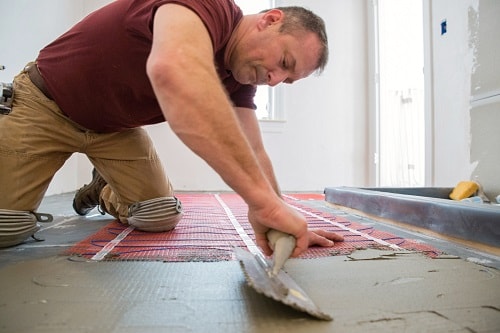

Heated bathroom floor install#
A few companies also install solar panels to power these systems.Įlectric radiant underfloor systems use electronic cables that run under the floor to give off heat. These systems are usually highly energy-efficient, so you can keep your house warmer for less money.

However, underfloor heating could lower your overall energy bill if it keeps your rooms warm enough that you use your furnace less or set it to a lower temperature. Energy costs: You’ll have to pay for the energy your system uses once it’s installed.
Heated bathroom floor professional#
If you look at the installation instructions and decide you’d rather have a professional do the work, you’ll pay $55 to $75 per hour. However, you may need to buy special tools, so don’t forget to factor those in when making your budget. If you install it yourself, you’ll save money.

Installation costs: Many companies advertise the ease of installing one of their underfloor heating systems.When considering radiant floor heating costs, don’t forget to think about installation and energy costs. Many companies have online tools for calculating radiant floor heating costs per square foot for one of their systems, so visit a few manufacturers’ websites to get a ballpark estimate. How much do heated floors cost?ĭepending on the type of system you choose and the size of the area you’re heating, a radiant floor heating system will cost between $4 and $9 per square foot, not including the cost of the floor covering. The heat from the floor then radiates up and into your room, creating a consistent source of heat. Heated floors work by using electric coils, hot water tubes or air vents to warm the surface of your floor. Radiant heating is better for people with allergies because it doesn’t move dust and particles around your home and it’s more energy efficient. With forced air heating, hot air is blown through ductwork and vented into each room. Radiant heating is an alternative to forced air heating-the kind of heat produced by an HVAC furnace. Underfloor radiant heating offers the same benefits without taking up wall space and requires less maintenance. Radiators are one example of radiant heating. Then, the heat radiates out from those and warms your room. "I've actually seen them installed in a shower, where they put them on the bench seat and on the walls,” Truini says.Radiant heating systems provide direct heat to floor or walls. But, if there's a corner that isn't used often, you don't have to add any there.

For example, Truini explains, you can place them close together in front of a vanity where you might often stand. Wires snap into the system's honeycomb-like pattern to add heat where you want. Triuni recommends checking out Ditra Heat by the German company Schluter if you’re interested in going this route. High-voltage wiring works somewhat differently, but is also more customizable within the space. “That means that the heat can come straight through!” Installation includes laying down a suitable tile backer, spreading mortar, and then placing electric mats in the mortar, with more added on top. He adds that the mats even come in custom sizes to fit around essentials like vanities and toilets. Electric mats come in standard sizes, and they’re cut to fit, says Truini.


 0 kommentar(er)
0 kommentar(er)
